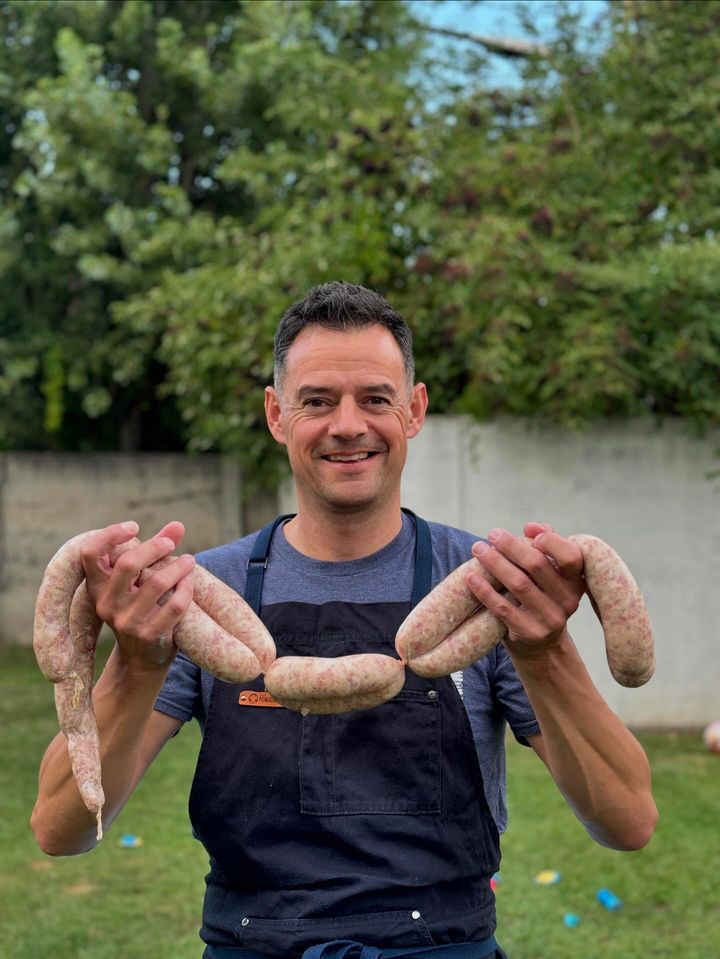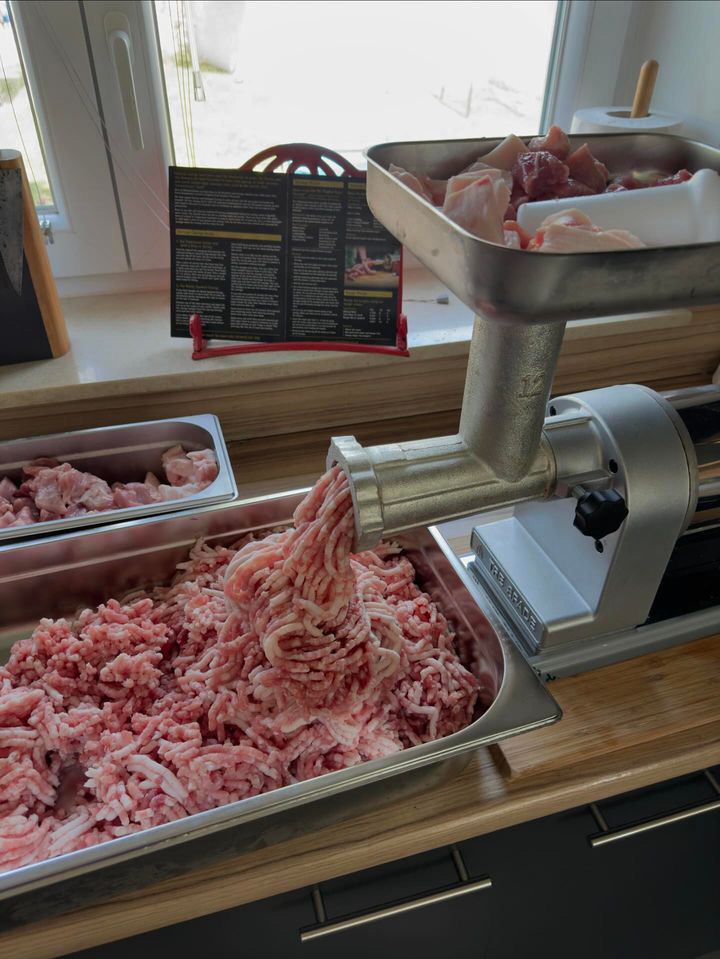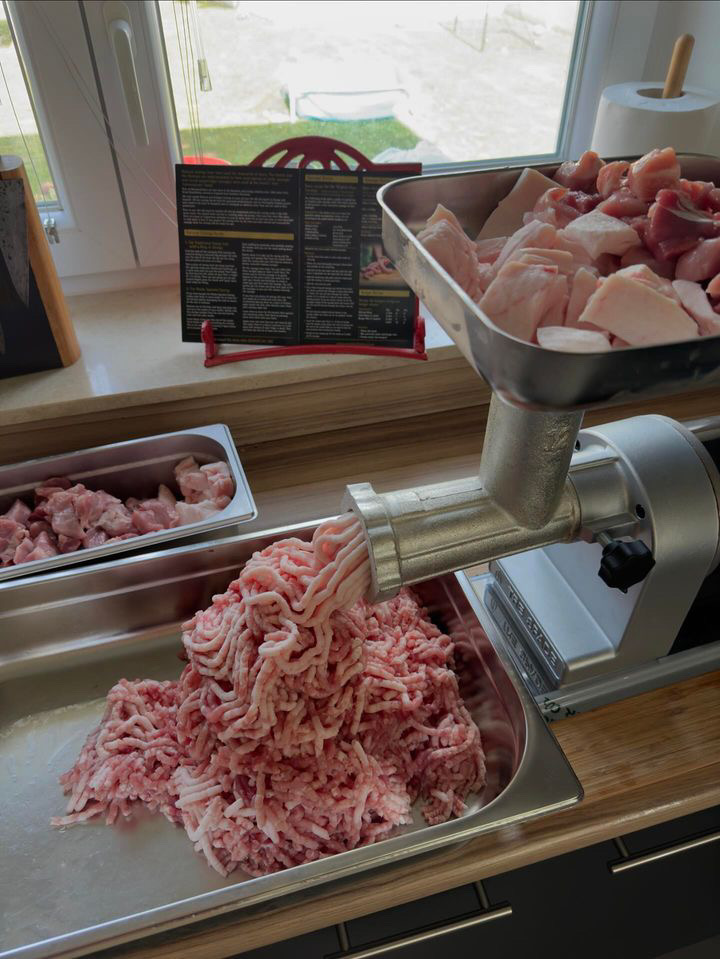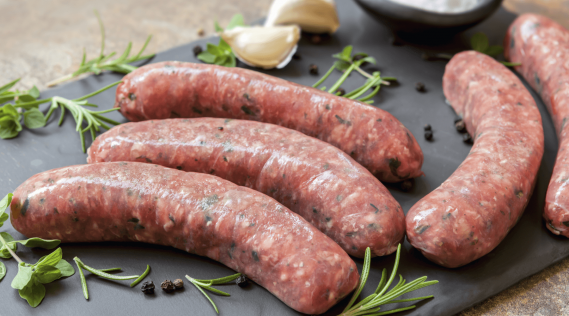Tim takes us through his sausage-making experience as a complete beginner over in Hungary. Born in the UK but now living in Hungary with his partner and children, Tim simply missed the taste of humble British Banger, so as a guest blog he is taking you on the journey of what it's like to be a beginner sausage maker and maybe some of the challenges you come across.
ABOUT ME


I’ve loved sausages for as long as I can remember. If I think about it, I didn’t just eat them for breakfast. There was also the humble sausage sandwich, toad in the hole, sausage casserole, bangers and mash, and battered sausage from the fish and chip shop or a hot sausage roll, but nothing could beat that crisp bite into a traditional British breakfast sausage.
Since I moved to Hungary 2 years ago with my family I’ve been having a great time exploring the local cuisine - there is a lot more to Hungarian food than goulash, but I do miss the taste of the great British Banger.
Of course, Hungarians believe unflinchingly that their sausages are the best in the world. To be fair, they have a very strong claim, I just love the mildly spicy kolbász, and the Hurka blood sausages are to die for. But you certainly can't buy British sausages here.
Drastic times call for drastic measures. Time to re-create traditional British sausages at home. In Hungary!
MY SAUSAGE MAKING EXPERIENCE
Right, so I’ve convinced myself I am a ‘Beginner Sausage Maker’! Now what!
I’m not a chef or a butcher. I have broken down a side of pork a couple of times. But now I think about it, I’ve never actually made sausages. In truth, I’ve always wanted to have a go. But the thought of trying to control a stream of projectile sausage meat into fiddly sausage casings always intimidated me.
So can I make a sausage? And can I achieve the same results at home as butchers who have years of training, specialised equipment and are producing sausages in commercial quantities?
Let’s find out!
INGREDIENTS
Sausages are made the world over - each country‘s national sausages include ground or chopped meat with some kind of flavouring, but they all taste different. What is it about a British banger that makes it uniquely British?
1. Meat
British sausages are typically made with pork, lamb, beef or game. Sausages are a great way to use up any lower quality cuts of the animal. The trimmings from the butchering process are also used, making sausages fundamental to the ‘nose to tail’ ethos of the butchery process.
2. Fat
Fat is a critical ingredient in sausages. It keeps the sausage juicy and helps bind the sausage mixture. Most importantly it adds a lot of flavour. Porkback fat is the best fat to use. The meat and fat ratio is traditionally about 25%-30% fat.
3. Rusk
If you had asked me what rusk was before I started looking into sausage ingredients, I would have told you that rusk is a dry biscuit that you give to babies. But it turns out it is also a very important ingredient in traditional British sausages. And rusk is perhaps the thing that makes British sausages uniquely British. Rusk is made from a yeastless bread which is dried and ground into a fine crumb. It acts as a binder, pulling together all the other ingredients and it is respons ble for the uniform texture in your British Banger.
4. Seasonings
Here‘s where the fun begins. How you flavour your sausages is really up to you. Traditional British sausages are known for their savoury flavour profiles, often featuring a blend of herbs such as sage, thyme, and parsley, along with a hint of nutmeg and black pepper. There are of course the regional British classics such as Cumberland, Lincolnshire, and Old Yorkshire. And of course favourite flavour pairings such as pork and leek, chilli and garlic, and herby ‘Italian’ sausages. But you are only limited by your imagination. Just remember that getting the seasoning just right is the difference between an OK sausage and a great sausage.
5. Casings
Let’s be honest, the meat, fat, rusk and seasonings don’t actually become a sausage until you have squeezed them into a casing of some sort. Without a casing, you only have a patty. But it is the casings, and filling them that has always been the mental block for me. Sausage casings after all just a euphemism for animal intestines, which always struck me as a bit icky. And trying to load a long sticky intestine onto a sausage filling nozzle, then waiting for sausage meat to shoot out the end seemed like a recipe for disaster. Nevertheless, hog and sheep casings have been stuffed with meat all over the world for thousand of years. Those produced commercially are thoroughly cleaned, and are not sticky to touch, as I had always imagined. They are also much stronger than you would think.
6. Water
I wouldn’t normally include water in an ingredient list. But it is important to mention it here as it performs such an important function in the sausage making process. It distributes the seasoning throughout the mix and helps bind everything together. The rusk absorbs most of the water, making it swell and blend in with the other ingredients, and so is crucial to the overall texture of the sausage.
WHAT EQUIPMENT DO I NEED?
When you break it down, there are basically two core processes involved in making sausages. You need to be able to mince the ingredients and you need to fill the sausage casings. Your friendly local butcher will happily grind your meat, provided you buy it from him. But he certainly won't stuff your sausages for you. If you are an aspiring sausage maker, you really need a mincer and some kind of sausage stuffing tool or attachment. As with all things, you get what you pay for and if you make the right investment, these tools will last a lifetime.
The first time I made sausages I happened to have a cheap Amazon-type mincing machine with some basic mincing attachments which I use to make my mince and (believe it or not) make chutney. This certainly doesn’t fit into the ‘quality investment that will last a lifetime’ category but it made do for my first attempt.
REAL BRITISH SAUSAGE RECIPE
Now it’s time to choose a recipe and source the ingredients. Pork sausages are my favourite, and pork is the most popular meat in Hungary, so it is very easy to source. But authentic sausage seasoning and rusk just aren’t available here. And in any case, if I want to make sausages that taste like those you buy from a British butcher, then I need to source the same seasonings and ingredients that British butchers use to make their sausages.
And as you already know if you are reading this, it doesn’t take long to come across Weschenfelder and learn that they sausage-making specialists, and supply butchers up and down the country with everything sausage related. Their website is a great resource for any beginners, as it includes several sausage making videos and they are also extremely happy to provide advice on anything to do with sausage making, including equipment, techniques and where to start as a beginner. But perhaps best of all - they ship to Hungary? (and pretty much everywhere else too!)
I want to keep things simple for my first attempt, so I decided to go with Weschenfelder’s Old Yorkshire Seasoning and their Yeastless Bread Rusk. Old Yorkshire is a herby seasoning that isn't too overpowering and makes an excellent breakfast sausage which is exactly what I was after. For the casings I opted for the Home Pack Spooled Hog Casings. These are pre-spooled on a plastic rod which I am assured makes it very easy to slide on to the sausage stuffing nozzle. Perfect. To make things even easier, the delivery arrived with Weschenfelder’s ‘Guide to Natural Casings and Recipes for Sausages and Burgers’ which included a recipe designed to work with a full 227g seasoning pack.
TIME TO MAKE SOME SAUSAGES
Now I’ve completed my research, decided on a recipe and sourced my ingredients and I’m ready to go. The recipe actually looks quite straightforward.
Mincing and Mixing
Firstly I minced my lean pork through my mincer’s largest plate. I then did the same with the pork fat and added the meat, the fat and the seasoning into my large bowl and gave it a rough mix. I then added the water and gave it a thorough mix for 30 seconds until it became evenly moist and sticky, and didn’t look like minced meat any more.
I then added the rusk and mixed it until well combined. This was actually quite hard work as by this point there was around 6KG of ingredients in the bowl. The consistency and texture looked good to me so I decided not to pass the mixture through the mincer a second time.
Preparing the Casings
This is the stage I was both excited and nervous about. First of all the casings need to be soaked in warm water, partly to remove the salt that they are stored in, but also to soften and lubricate them making them flexible enough for when it comes to filling them with meat.
It was then just a case of taking the blue washers off, sliding the casing off the end of the plastic rod and onto my sausage nozzle. I used the home pack ready spooled hog casings. Each spool has 10 metres of casing, so I cut the casing when I decided there was enough on the nozzle.
Filling and Linking the Sausages
I loaded up the mincer’s hopper with the sausage mixture, turned on the mincer, and started to push the meat into the mincer with the plunger. It took a few seconds for the sausage meat to get to the business end, but sure enough, the sausages started to started to unfurl from the nozzle, filled with the sausage mixture.
I’m making sausages!!!
Linking is an art form. After watching several videos online, I found one I thought I could just about follow. But this is definitely an art form that needs a lot of practice. And one I knew I wouldn’t perfect on the first try. At one point it felt like I was tying myself in knots, and not the sausage!
Yet I must say, how satisfying to watch the sausages take shape. It was a lot of fun. And the end result was a lot of what looked to me like very British Bangers!
HOW DID I DO?
Overall, I’m extremely happy with my first attempt at sausage making. It was a lot of fun. I knew things wouldn’t be perfect. My sausages were a bit uneven in a few places, and I managed to tie them into varying lengths but definitely looked like proper British sausages.
What blew me away was the taste. These Cumberland sausages taste just like the ones you can buy from British butchers throughout the UK. To have made these at home, in Hungary is amazing. I think it is worth repeating that if you want to make traditional British butcher’s sausages then it makes sense to source your ingredients from the same place that British butchers do.
10 TIPS FROM A BEGINNER SAUSAGE MAKER
1. Soaking pre-spooled casings: the plastic spools float, so spin them around occasionally during soaking so that the tops soak too.
2. Make your sausages in bulk and freeze them in batches.
3. Always use the best quality ingredientsIf you want to make sausages that taste like those you buy from a British butcher, then it makes sense to buy the same seasonings and ingredients that British butchers use to make their sausages.
4. The plastic rods that the pre-spooled casings come on were just a little bit too long the containers I had; however, it was easy to trim a few centimetres off the plastic rod so that it fitted
perfectly in a 1/3 hotel pan.
5. Make sure the meat and fat are very cold when you mince them to avoid it going mushy and clogging up your mincer.
6. The key to linking sausages is practice, practice, practice. This is the video I used.
7. Rest your sausages in the fridge for a few hours to allow the flavours to develop before cooking.
8. You don’t need semi-professional equipment to make sausages, but a sausage stuffer will really improve your experience.
9. Invest in a big mixing bowl. Not only does it need to be big enough to hold the actual ingredients. But you also need some space in your bowl to work your mixture.
10. The nozzle should be 10-15mm smaller than the diameter of the casings to aid the flow of the sausage meat into the casing whilst also ensuring you don't split or damage your casing trying to get it onto the end of the nozzle. For example, if your casing has a diameter of 34mm, use a nozzle that is 20mm.
Side Note
After making my first batch of sausages, I have since bought the Tre Spade TC-12 El/160 Electric Mincer, which has made life so much easier and will help speed up my butchery adventures.
Below is my latest batch where I minced the meat and fat together to create an evenly distributed mixture.


As a keen cook, Tim has a recipe blog where you can find out about his other cooking adventures. Heavily influenced by Hungarian, British & Italian foods, you will be hard-pushed to resist trying some of his mouthwatering recipes here.
Check out his website: www.timransome.com




